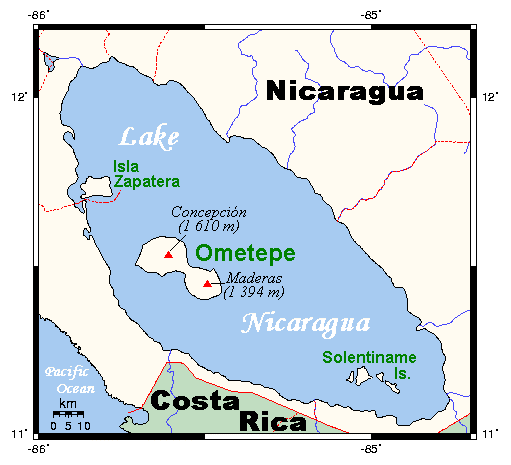An international research group has developed a mathematical model aimed at defining the optimal sizing of a hybrid renewable energy system for island communities.
The proposed model was conceived for an energy system based exclusively on wind and solar power generation coupled with a mix of pumped hydro and battery storage. It was utilized to analyze the economic feasibility of a similar system in Ometepe, which is an island formed by two volcanoes rising out of Lake Nicaragua in Nicaragua.

Image: wikimedia commons, https://bit.ly/2QF0f7E
The island was chosen as it is rich in wind and solar resources and has a crater lake at the top of an extinct volcano that can be used as the upper reservoir of a pumped-hydro storage facility, and is located in a tropical freshwater lake that could act as the lower reservoir. The pumped hydro unit is expected to provide most of the storage operations and the battery bank is used only if the upper reservoir is full or is not able to operate.
The scientists explained that, in order to identify the optimal installed capacity of the proposed off-grid renewable energy system, the cost of energy (COE) must be optimized while ensuring a reliable power supply. The optimization process is implemented through an algorithm called Multi-objective Grey Wolf Optimize, which is a kind of algorithm mimicking the leadership hierarchy and hunting mechanism of gray wolves in nature. “Since this project aims at increasing renewable energy penetration, only solutions that achieved at least a 95% level of power supply reliability are adopted,” they explained. “In this regard, the model applies a penalty factor to low-reliability solutions.”
The system’s long term performance was analyzed through an hourly time-step simulation over 13 consecutive years, from 2007 to 2019.
Popular content
The researchers found that the island's total electricity demand can be met with a COE of €0.095/kWh for a power supply reliability of 97.5%. Furthermore, they found that for a 99% level of power supply reliability, the achieved COE was €0.081/kWh; and for 100% reliability, it was €0.067/kWh. “This range of values aligns with the observed behavior for COE in Nicaragua in 2020,” they stated, noting that solar should represent around 70% of the system's installed capacity.
“The sensitivity analysis conducted for different combinations of capex and loss of power supply probability (LPSP) estimated that the COE ranges between €0.047/kWh and €0.095/kWh, based on international reference capex values,” they concluded.
The study, published in Sustainable Energy Technologies and Assessments, also considered the possibility of producing green hydrogen from surplus wind and solar power, but the construction of an electrolyzer of 5 MW, which was the minimum size required, was found to be difficult to implement.
The research team included scientists from Universidad de la Costa, in Colombia, AGH University in Poland, the Universidade Federal do Rio Grande do Sul, in Brazil, and the Mostaganem University, in Algeria.
This content is protected by copyright and may not be reused. If you want to cooperate with us and would like to reuse some of our content, please contact: editors@pv-magazine.com.



Is there heat in the volcano that will lead to evaporation of the water?